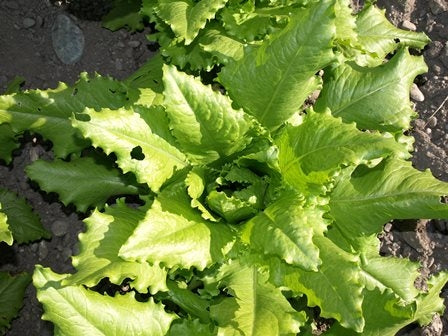VENETIAN CUTTING LETTUCE - ps50
Have a question?

VENETIAN CUTTING LETTUCE - ps50
Dettagli
Species: Lactuga sativa and Cichorium intybus
Family: Composite.
Brief history and botanical notes on the plant
Cutting salads include various cultivated species: rocket, mizuna, lettuce, lamb's lettuce, radicchio, etc. We will mainly deal with Lactuga sativa (e.g. blond cutting lettuce) and Cichorium intybus (e.g. Verde a grumolo" or "Grumolo ” or “Scirolo”) often mixed together in seed sachets ready for use. Both are easy to grow even for the hobbyist horticulturist. For botanical notes, refer to the technical data sheets already covered for lettuce and radicchio.
Family and variety
When referring to cutting salads, two species are mainly considered: Lactuga sativa and Cichorium intybus, both belonging to the Composite family.
Seed retailers generally promote seed bags already prepared with mixtures of multiple varieties (e.g. 11 lettuces and 4 chicory) which take the generic name of "mixed vegetables". They are very decorative salads (from green to red) and tasty due to the richness of the mixed varieties but it is still possible to grow single varieties.
In cutting lettuces, the acephala variety includes varieties such as Trentina, Comune, Lollo, Verde ricciolina, Bionda ricciolina, Spinacio and American curly lettuce.
Chicory or radicchio (Cichoriumintybus) is a perennial herbaceous plant, in cut chicory the leaves are arranged like the petals of a rose ("basal rosette"); this arrangement is very evident in the "Dark green Grumolo" or "scirolo" variety, in other varieties the leaves are mostly narrow and elongated.
Pedoclimatic needs
These species stop their growth at 6C°, but resist temperatures down to -2C°. It is important to remember the "seed mounting" which is stimulated by temperatures above 25C° during the day and 14C° at night. They are all rustic and undemanding species, they can be grown all year round taking into account seasonal temperatures and business opportunities (heated greenhouses, cold tunnels, open fields,...).
Sowing and transplanting times
Sowing in the field can be carried out in two seasonal periods: spring (approximately mid-February until the end of April) and autumn (September - October). They are sown in continuous rows (or on broadcast beds) maintaining a distance between the rows of 15-25 cm depending on the equipment used for mechanical weeding (hoe or tractor!).
Fertilizations
Cutting salads are not very demanding on nitrogen and phosphorus and benefit from a medium availability of potassium. Significant background fertilization is therefore essentially not necessary for these crops which can be part of an initial or final crop rotation program using the residual fertility of the soil.
Crop care and irrigation
In the cultivation of cutting salads, transplanting is not carried out but direct sowing in the field or under forcing (tunnel or greenhouse). Cultivation care involves preparing the seedbed with superficial and "light" tillage and controlling weeds in the rows with mechanical means.
Irrigation must be carried out to encourage the germination of the seedlings, considering that the soil must then maintain a certain humidity without becoming unnecessarily soaked in water which could cause asphyxiation and rot.
Adversity
No specific adversities were reported. It is good practice to maintain good succession in the garden to avoid the possibility of the establishment of fungal pathogens (fusarium) which generally affect specialized monocultural plants in which there is no alternation in vegetable cultivation. Chicories are also extremely rustic.
Production and collection
In 1 m2 you can collect approximately 1 kg of cutting u. Harvesting begins approximately 50-60 days after sowing, cutting the leaves (preferably with scissors) 3 cm from the ground when they have reached approximately 15 cm in height. Subsequently, new leaves grow which lasts for about 45 days, allowing 2-4 harvests. In the vegetable garden it is possible to sow about 10-12 days apart to encourage continuous harvests to scale over time.
Nutritional values
From a nutritional point of view, lettuces are rich in vitamins (A and C), mineral salts (calcium, iron, magnesium, potassium) and soluble fibre, particularly effective in preventing atherosclerosis. Since ancient times, all types of lettuce have been recognized as having calming, refreshing, analgesic, antioxidant and appetite-stimulating properties. It would be good to start every meal with a plate of fresh lettuce.
Although the different varieties of chicory are often valued only from a gastronomic point of view, we must not forget that they can also play an interesting role in nutritional and therapeutic integration. In fact, they contain a good quantity of minerals, calcium and iron in particular, which contribute significantly to the good functioning of the organism. The richness in fiber of these vegetables stimulates daily defecation and facilitates water exchange by activating diuresis. Furthermore, their consumption increases the production of bile by the liver, stimulating the purifying function of the organ itself and contributing to the reduction of cholesterol in the blood.
Biodynamics
Sowing, cultivation care and harvesting on leaf days. If the cultivated soil tends to be asphyxiated and compact, in addition to promoting aeration with appropriate tillage, it may be useful to use horsetail macerate to prevent the entry of fungal pathogens for the more sensitive lettuces.



